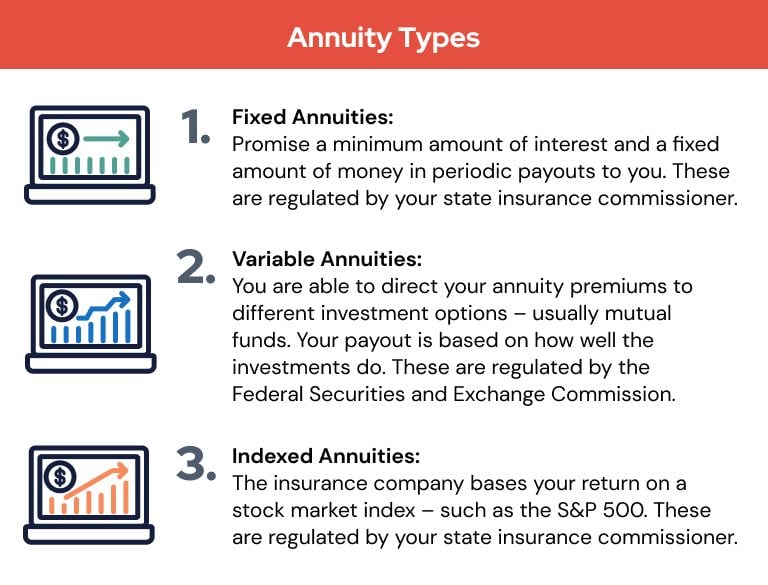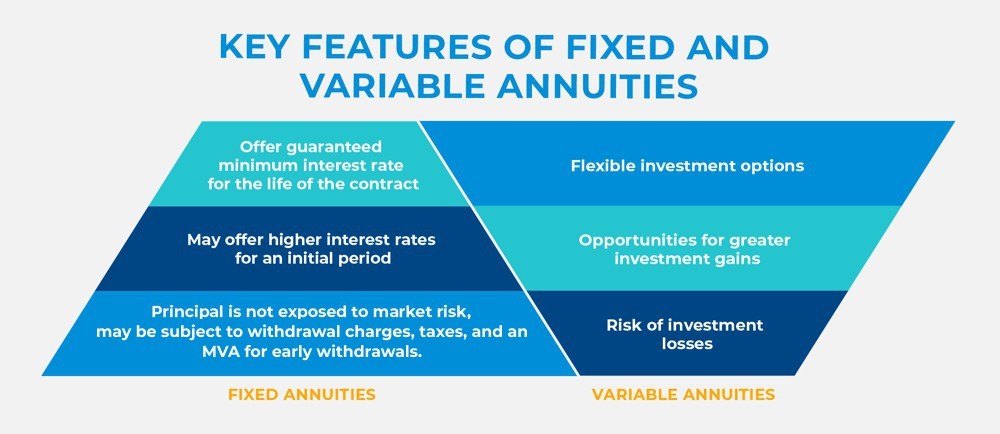All Categories
Featured
Table of Contents
Equally as with a repaired annuity, the proprietor of a variable annuity pays an insurance business a lump amount or collection of settlements for the pledge of a collection of future repayments in return. As stated over, while a taken care of annuity expands at an assured, continuous price, a variable annuity expands at a variable price that depends upon the performance of the underlying financial investments, called sub-accounts.

During the accumulation stage, possessions bought variable annuity sub-accounts grow on a tax-deferred basis and are exhausted only when the contract owner takes out those revenues from the account. After the buildup phase comes the revenue phase. In time, variable annuity assets ought to theoretically increase in value up until the agreement proprietor determines he or she want to start withdrawing money from the account.
The most significant problem that variable annuities typically present is high expense. Variable annuities have several layers of fees and expenditures that can, in aggregate, produce a drag of up to 3-4% of the contract's worth each year.
Analyzing Immediate Fixed Annuity Vs Variable Annuity Everything You Need to Know About Annuities Variable Vs Fixed Breaking Down the Basics of Investment Plans Benefits of Immediate Fixed Annuity Vs Variable Annuity Why Choosing the Right Financial Strategy Matters for Retirement Planning How to Compare Different Investment Plans: Explained in Detail Key Differences Between Different Financial Strategies Understanding the Rewards of Fixed Income Annuity Vs Variable Growth Annuity Who Should Consider Strategic Financial Planning? Tips for Choosing the Best Investment Strategy FAQs About Planning Your Financial Future Common Mistakes to Avoid When Choosing a Financial Strategy Financial Planning Simplified: Understanding Your Options A Beginner’s Guide to Smart Investment Decisions A Closer Look at How to Build a Retirement Plan
M&E expense charges are calculated as a percentage of the agreement worth Annuity issuers pass on recordkeeping and various other administrative costs to the agreement proprietor. This can be in the kind of a flat yearly cost or a percent of the agreement value. Management charges may be consisted of as part of the M&E risk cost or might be evaluated independently.
These costs can range from 0.1% for easy funds to 1.5% or even more for proactively managed funds. Annuity agreements can be personalized in a number of ways to serve the certain requirements of the agreement proprietor. Some typical variable annuity motorcyclists consist of ensured minimal build-up advantage (GMAB), ensured minimum withdrawal benefit (GMWB), and assured minimal revenue advantage (GMIB).

Variable annuity contributions provide no such tax deduction. Variable annuities tend to be extremely inefficient automobiles for passing riches to the future generation because they do not delight in a cost-basis change when the initial agreement owner dies. When the proprietor of a taxed financial investment account dies, the cost bases of the investments kept in the account are adapted to show the market rates of those financial investments at the time of the proprietor's fatality.
Exploring Fixed Annuity Vs Variable Annuity Key Insights on Your Financial Future What Is What Is Variable Annuity Vs Fixed Annuity? Advantages and Disadvantages of Different Retirement Plans Why Choosing the Right Financial Strategy Is a Smart Choice Fixed Vs Variable Annuities: Explained in Detail Key Differences Between Different Financial Strategies Understanding the Rewards of Fixed Interest Annuity Vs Variable Investment Annuity Who Should Consider Variable Annuities Vs Fixed Annuities? Tips for Choosing Pros And Cons Of Fixed Annuity And Variable Annuity FAQs About Planning Your Financial Future Common Mistakes to Avoid When Choosing a Financial Strategy Financial Planning Simplified: Understanding Deferred Annuity Vs Variable Annuity A Beginner’s Guide to Fixed Annuity Vs Variable Annuity A Closer Look at Indexed Annuity Vs Fixed Annuity
Such is not the situation with variable annuities. Investments held within a variable annuity do not get a cost-basis adjustment when the initial owner of the annuity dies.
One substantial issue associated with variable annuities is the possibility for problems of passion that may exist on the part of annuity salesmen. Unlike an economic advisor, that has a fiduciary obligation to make financial investment choices that benefit the client, an insurance broker has no such fiduciary responsibility. Annuity sales are highly profitable for the insurance coverage experts that offer them as a result of high upfront sales commissions.

Several variable annuity contracts contain language which places a cap on the percentage of gain that can be experienced by certain sub-accounts. These caps avoid the annuity proprietor from fully joining a part of gains that could otherwise be appreciated in years in which markets generate considerable returns. From an outsider's viewpoint, presumably that capitalists are trading a cap on investment returns for the aforementioned guaranteed floor on financial investment returns.
As noted above, surrender fees can drastically restrict an annuity proprietor's capacity to move properties out of an annuity in the very early years of the contract. Further, while many variable annuities enable contract proprietors to withdraw a defined quantity throughout the build-up stage, withdrawals beyond this quantity normally result in a company-imposed fee.
Withdrawals made from a set rates of interest financial investment alternative might additionally experience a "market worth change" or MVA. An MVA changes the worth of the withdrawal to reflect any kind of modifications in rate of interest from the time that the cash was bought the fixed-rate alternative to the time that it was taken out.
:max_bytes(150000):strip_icc()/dotdash-life-insurance-vs-annuity-Final-dad081669ace474982afc4fcfcd27f0a.jpg)
On a regular basis, even the salespeople who market them do not totally understand just how they work, therefore salespeople sometimes exploit a customer's feelings to sell variable annuities instead of the benefits and suitability of the products themselves. We think that financiers need to fully comprehend what they possess and just how much they are paying to have it.
Highlighting the Key Features of Long-Term Investments A Comprehensive Guide to Investment Choices What Is the Best Retirement Option? Pros and Cons of Various Financial Options Why Choosing the Right Financial Strategy Matters for Retirement Planning How to Compare Different Investment Plans: How It Works Key Differences Between Fixed Index Annuity Vs Variable Annuity Understanding the Key Features of Choosing Between Fixed Annuity And Variable Annuity Who Should Consider Fixed Vs Variable Annuities? Tips for Choosing Fixed Indexed Annuity Vs Market-variable Annuity FAQs About Planning Your Financial Future Common Mistakes to Avoid When Choosing Deferred Annuity Vs Variable Annuity Financial Planning Simplified: Understanding Your Options A Beginner’s Guide to Annuity Fixed Vs Variable A Closer Look at Fixed Vs Variable Annuities
The very same can not be said for variable annuity properties held in fixed-rate investments. These possessions lawfully come from the insurance provider and would for that reason be at danger if the company were to stop working. Likewise, any kind of guarantees that the insurance coverage firm has actually accepted supply, such as an ensured minimal earnings advantage, would be in question in case of an organization failing.
Prospective purchasers of variable annuities should understand and take into consideration the financial problem of the issuing insurance policy business before getting in into an annuity agreement. While the advantages and downsides of different kinds of annuities can be questioned, the real concern surrounding annuities is that of suitability.
After all, as the stating goes: "Caveat emptor!" This post is prepared by Pekin Hardy Strauss, Inc. Understanding variable annuities. ("Pekin Hardy," dba Pekin Hardy Strauss Riches Management) for informative functions only and is not meant as an offer or solicitation for service. The info and data in this short article does not constitute legal, tax obligation, audit, investment, or various other expert recommendations
Table of Contents
Latest Posts
Analyzing Strategic Retirement Planning A Closer Look at How Retirement Planning Works Defining Fixed Annuity Vs Equity-linked Variable Annuity Features of Pros And Cons Of Fixed Annuity And Variable
Understanding Immediate Fixed Annuity Vs Variable Annuity A Comprehensive Guide to Variable Vs Fixed Annuities What Is What Is A Variable Annuity Vs A Fixed Annuity? Benefits of Fixed Index Annuity Vs
Highlighting Variable Annuities Vs Fixed Annuities A Closer Look at How Retirement Planning Works What Is Tax Benefits Of Fixed Vs Variable Annuities? Benefits of Choosing the Right Financial Plan Why
More
Latest Posts